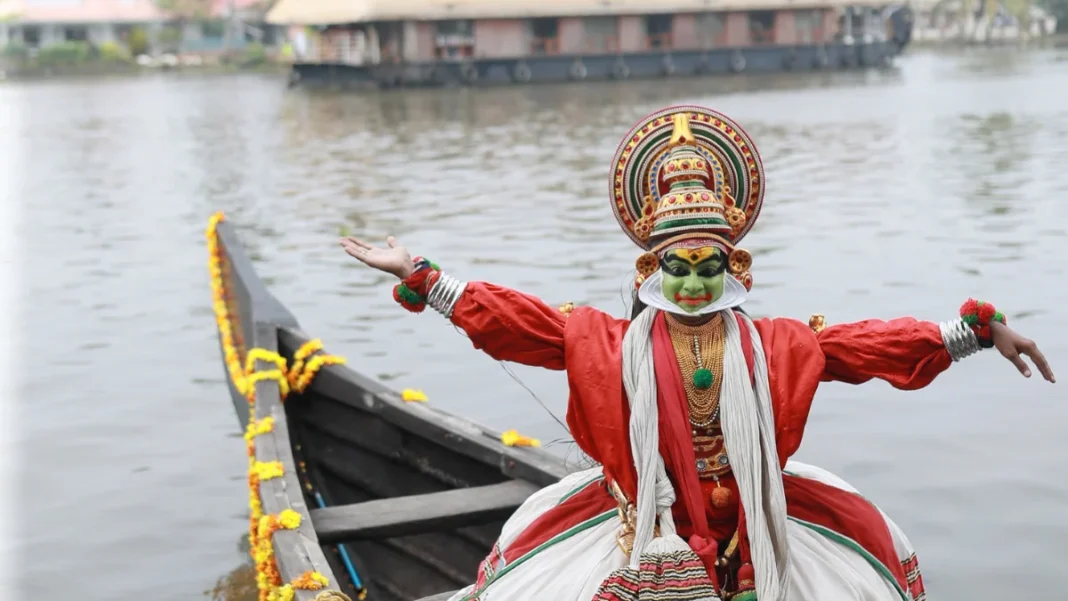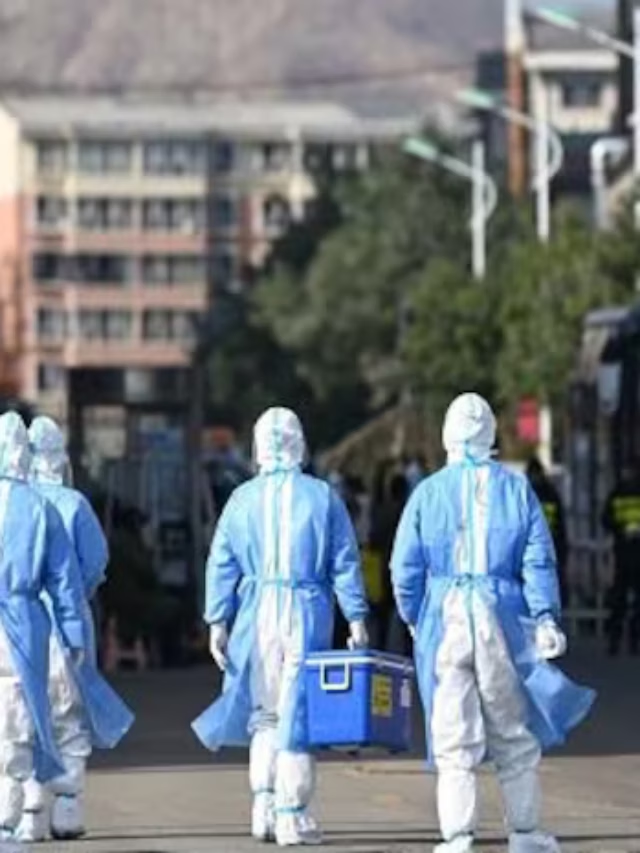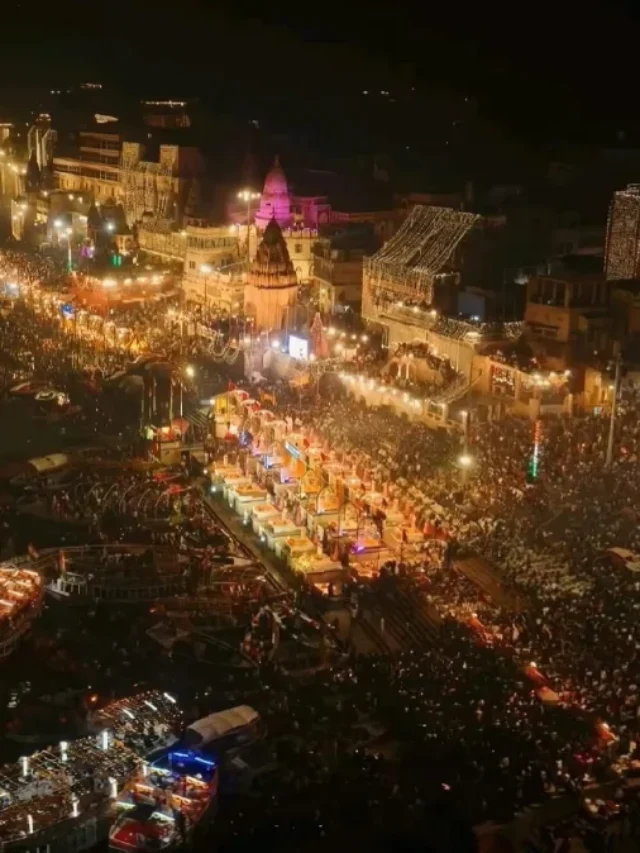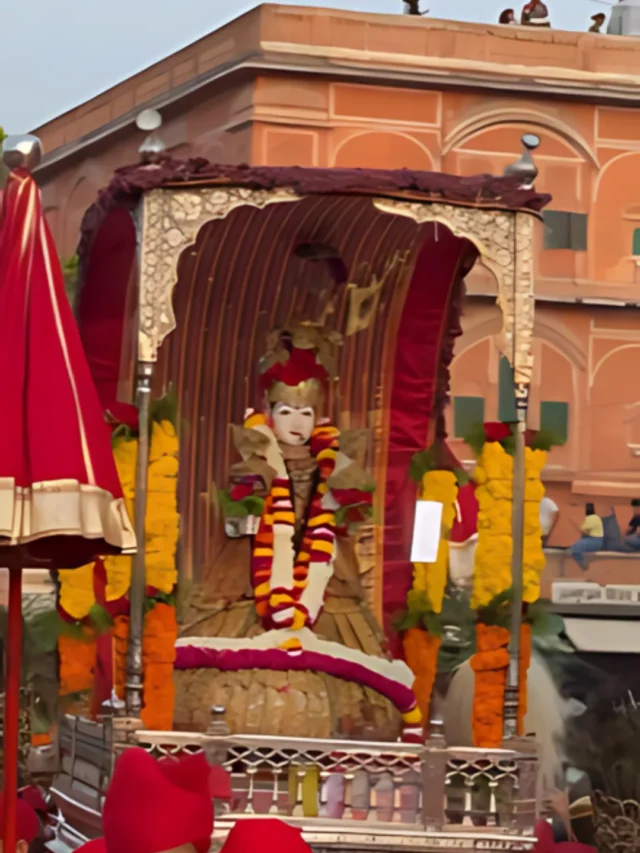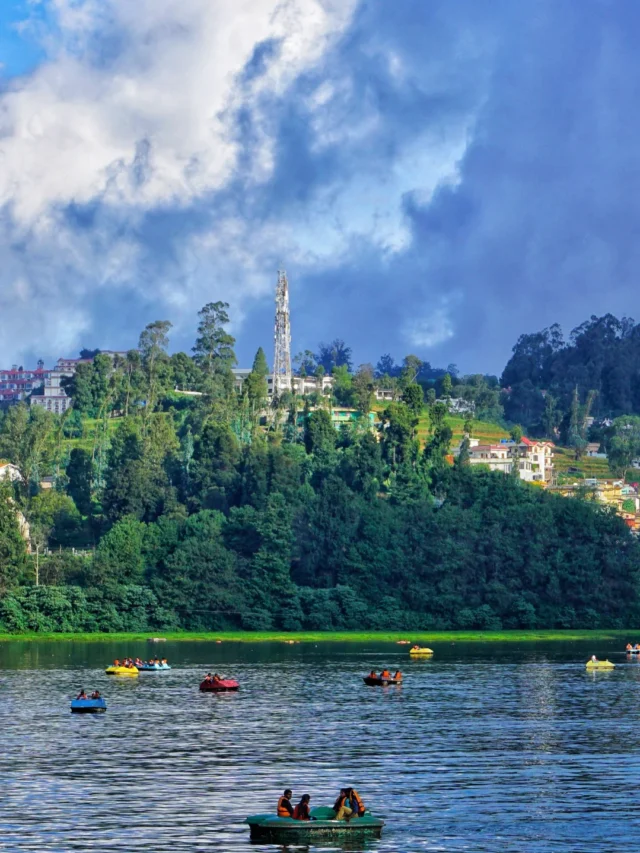Kerala is a gorgeous state covered in timeless glamour. It is known not only for its natural beauty but also for its varied art forms that have gifted the country with many talented artists from the music industry to the visual arts industry. The many arts of Kerala are popular worldwide, and some have also made it to the UNESCO Intangible Cultural Heritage list! Let’s check some of them out, and make sure to witness them on your next trip to this beautiful place!
14 Arts of Kerala
1. Kathakali
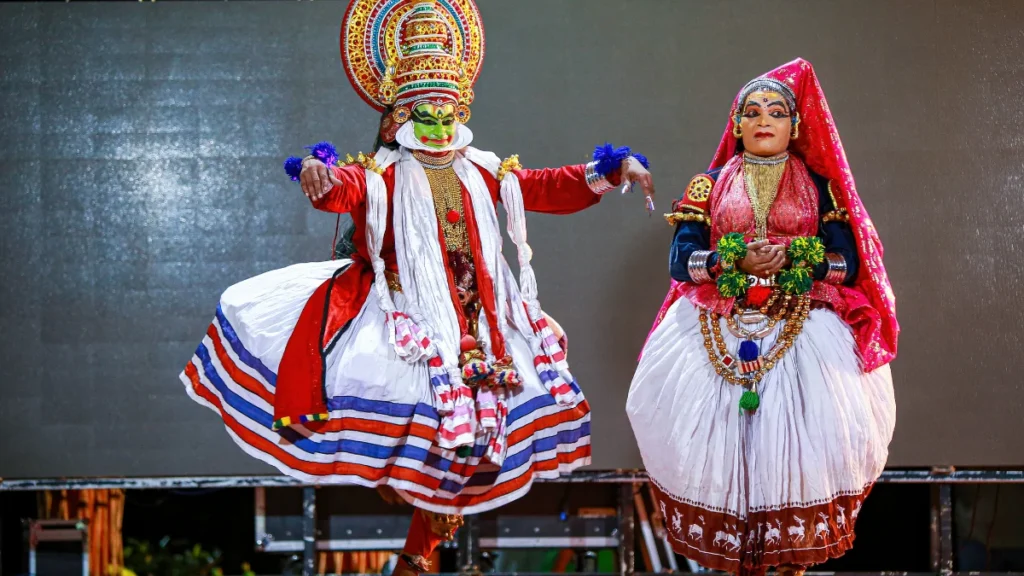
The incandescent jewel of Kerala’s cultural legacy, kathakali is a captivating dance-drama that exists beyond time. One of the oldest arts of Kerala, it has been practised for generations. It is performed on a stage with a symphony of emotions, brilliant colours, and complex costumes. Entertainers decked up in elaborate makeup representing legendary figures use a captivating combination of coordinated motions and expressive gestures to bring stories from the Mahabharata and Ramayana to life. Resonant voices and the rhythmic cadence of traditional instruments like the chenda and maddalam create a tapestry of sound that amplifies the dramatic effect. Attending a Kathakali performance in Kerala is an invitation to dive headfirst into the creative tradition of the state, a moving cultural journey that satisfies viewers’ desire for more. It’s more than simply an aesthetic experience.
Enter a realm where stories are told via the expressive language of dance and mythology comes to life. Keralan Kathakali opens a portal to a mesmerising world where each deftly rendered expression and thunderous drum beat conveys a timeless story. Take in the show and allow the captivating charm of Kathakali to carry you away to a world where narrative, creativity, and tradition come together to celebrate Kerala’s rich cultural heritage.
2. Kalaripayattu

Kalaripayattu is one of the oldest martial arts in Kerala. The vibrant and enthralling display of Kalaripayattu, an ancient martial art form that originated in the state of Kerala in southern India, is impressive. This discipline, whose origins date back more than 3,000 years, skillfully combines grappling, striking, kicking, and weapons methods. Practitioners put on a captivating visual show with their extraordinary flexibility, speed, and precision in their motions while dressed in traditional garb. Kalaripayattu is more than simply a martial art; it’s a way of life because of its holistic approach, which incorporates spirituality, self-defence, and physical conditioning. Kalaripayattu is an old and intriguing art form that captivates viewers and aficionados alike with its rhythmic choreography and harmonic combination of power, agility, and cultural legacy. The traditional sounds of drums back the performance.
3. Theyyam
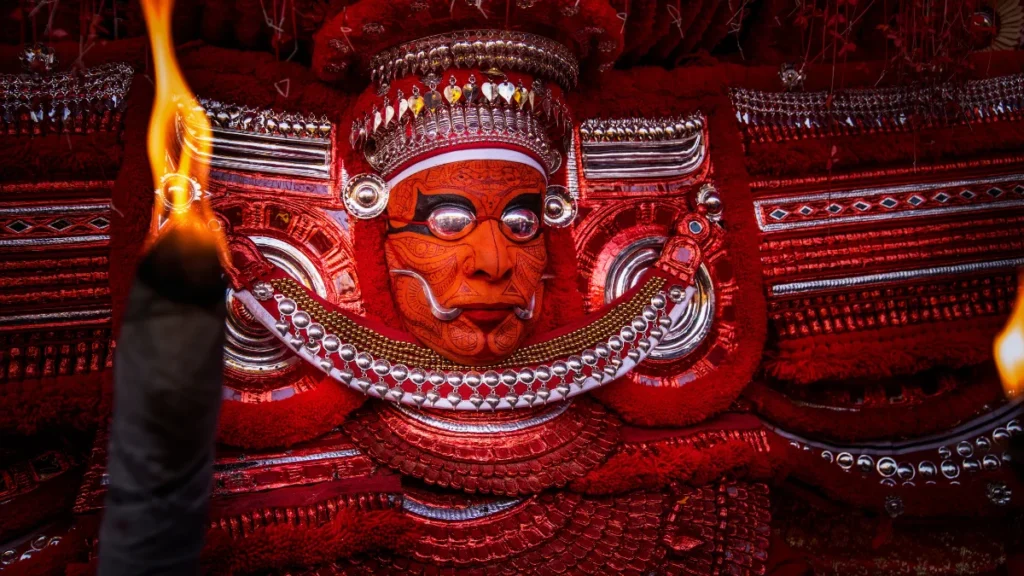
The mesmerising ceremonial dance style known as “theyyam,” which originated in the northern Malabar area of Kerala, is a striking representation of spiritual ardour and cultural diversity. With elaborate costumes, captivating makeup, and complex rituals, this age-old performance art—which has its roots in local customs—transforms its practitioners into living deities, bringing the stories of gods and goddesses to life. For both participants and onlookers, the artists’ colourful and energetic gestures, combined with the rich sounds of traditional percussion instruments, produce a sublime experience. Theyyam is more than just a dance; it’s a holy ceremony that unites the divine and the earthly realms and strengthens the bond between the dancers and the spiritual beings they represent. Kerala’s rich heritage of mythology, culture, and devotion is exhibited in the vibrant tapestry of Theyyam, one of the ritualistic arts of Kerala.
4. Koodiyattam
One of the earliest theatre genres still in existence today is koodiyattam, a classic Sanskrit play that has its roots in Kerala, India’s temples. Koodiyattam is a mesmerising fusion of dance, drama, and music that has origins dating back more than 2,000 years. As such, it is recognised as an Intangible Cultural Heritage by UNESCO. Events from classical Indian epics, such as the Ramayana and the Mahabharata, are usually the focus of performances; these are told with elaborate gestures, emotions, and rhythmic movements. Koodiyattam is unique because of its intricate makeup, symbolic costumes, and rigorous training regimen for its actors. The art form has persisted through the ages, transmitted via the Gurukulam, a customary system from gurus to followers. With its ageless stories and ability to capture the spirit of traditional performing arts in the current day, Koodiyattam is a monument to India’s rich cultural legacy.
5. Mohiniyattam
Kerala in southern India is the birthplace of the traditional dance style known as mohiniyattam, which is a beautiful and mesmerising display of artistic ability. It is one of the most well-known arts of Kerala. Mohiniyattam, also known as the “Dance of the Enchantress” or the “Dance of the Mohini,” is a dance style that is distinguished by graceful movements, deft footwork, and expressive facial expressions. Mohini is a mythological enchantress from Hindu mythology. The dancing style combines a variety of hand gestures, known as mudras, with subtle eye motions and complex rhythmic patterns set to traditional Carnatic music.
Elegantly and poisedly, dancers present celestial tales from Hindu mythology and tradition, frequently dressed in white and gold robes. The use of the distinctive Mohiniyattam costume—which comes with a unique set of jewellery—enhances the image. The dance genre enthrals viewers with its lyrical movements and emotional depth, emphasising storytelling, beauty, and femininity. Mohiniyattam is a perfect example of the ageless beauty of Indian classical dance, as well as the cultural legacy of Kerala.
6. Padayani
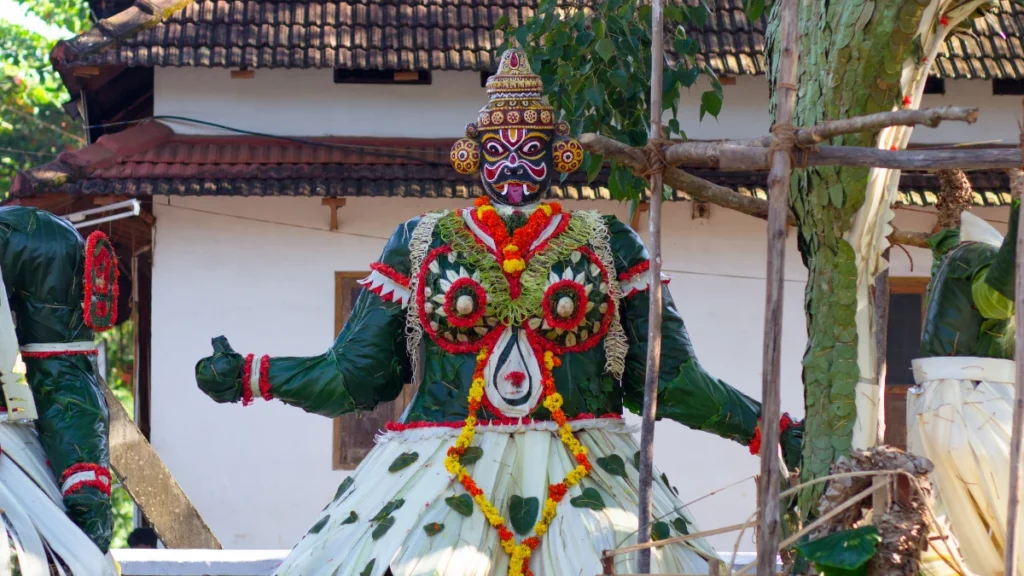
One of the ritual arts of Kerala’s central Travancore area, padayani is a colourful folk dance that embodies both religious devotion and cultural diversity. Known for its association with Bhadrakali temples, Padayani is a festive performance that showcases an elaborately ornamented procession of actors with vibrant, huge masks and costumes. This art form gains a spiritual dimension from its thematic focus on the goddess Bhadrakali and its symbolic representation of the victory of good over evil. The intricate headdresses create a visually striking and spiritually charged environment, as painted wooden masks and rhythmic rhythms of traditional percussion instruments all contribute to the visual and audio extravaganza. Padayani is a symbol of the cultural legacy and devotion of the Keralan people because of its close ties to regional customs and religious holidays.
7. Chakyur Koothu
Kutiyattam, an ancient Sanskrit play, is intimately linked to Chakyar Koothu, a traditional performing art form that originated in Kerala, India. Chakyar Koothu is a solo performance where the Chakyar, a male performer from the Chakyar clan, relates events from Hindu epics like the Ramayana and Mahabharata using a blend of storytelling, wit, and humour. It is typically performed in temple precincts, especially during festivals.
Chakyar Koothu is distinguished by his use of complex movements and facial expressions, as well as his distinct storytelling technique. The performer, who is frequently dressed in traditional garb, draws in the audience with witty asides, societal critiques, and spontaneous exchanges, adding a vibrant and enjoyable touch to the narrative. Elathalam and mizhavu are two examples of traditional percussion instruments used to accompany the performance. Chakyar Koothu is an essential component of Kerala’s performing arts legacy since it serves as a vehicle for the preservation and intergenerational transmission of cultural and mythical tales in addition to providing pleasure.
8. Thullal
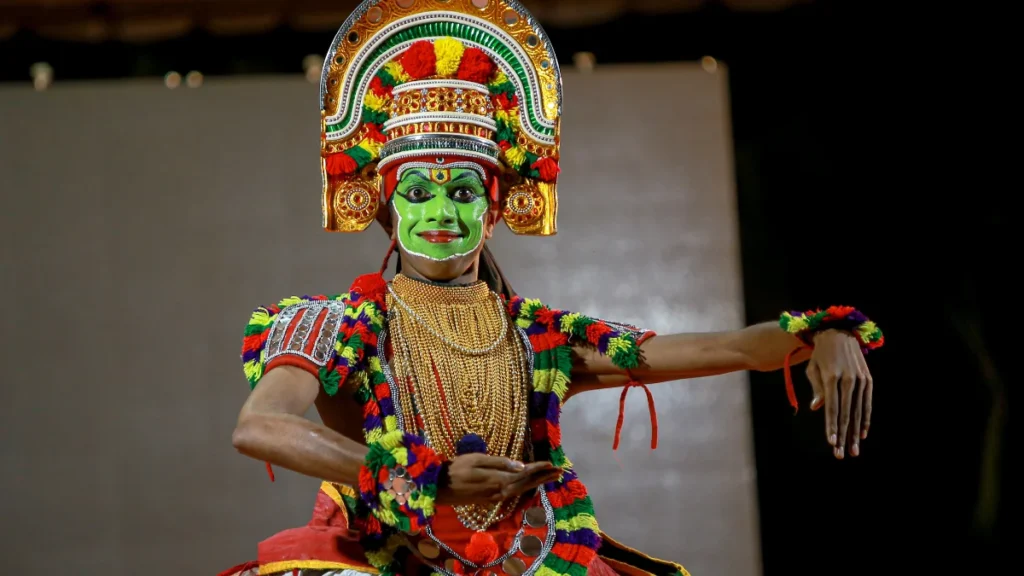
Poetry by Kunchan Nambiar is exemplified by Thullal, a vibrant and amusing dancing style that originated in Kerala, India. Thullal, which was created in reaction to the complexity of classical dance styles, values humour, simplicity, and social satire. A male dancer uses dynamic gestures, expressive facial movements, and rhythmic footwork to narrate and enact stories from mythology or everyday life in this solo performance art. Because the stories are presented in a more approachable way, and the actors do less makeup, Thullal stands out as an accessible and inclusive cultural event.
In Kerala, Thullal, accompanied by traditional percussion instruments and classical Carnatic music, has become a well-liked and well-known creative manifestation. Its capacity to combine moral instruction with fun has won over viewers across linguistic and cultural divides. In addition to showcasing the performers’ creative abilities, Thullal acts as a bridge across cultural divides, bringing people together via the exuberant celebration of human experience and common narratives.
9. Kutiyattam
One of the oldest theatrical traditions in the world, Kutiyattam is an ancient Sanskrit theatre that originated in Kerala, India, and has a history spanning over two millennia. Kutiyattam, one of the most diverse arts of Kerala, is performed in temples during religious rituals. Its unique elements include a slow-moving storytelling style, deft hand and facial movements, and legendary figures who breathe life into traditional Sanskrit plays. Kutiyattam performers go through rigorous training, frequently in the conventional Gurukulam curriculum. Kutiyattam is a monument to the cultural diversity of Kerala and the ongoing heritage of this extraordinary traditional performance art, having been recognised as a UNESCO Intangible Cultural Heritage.
10. Vela Kali
Dynamic folk dance Vela Kali is an enthralling fusion of martial techniques and cultural expression. This ancient dance style, which is usually performed at temple festivals and festive occasions, showcases expert male dancers demonstrating their agility, dexterity, and martial skills while brandishing swords and shields in a synchronised performance. The show reflects the rich cultural legacy of Kerala and is visually gorgeous and dynamically charged because of the rhythmic dancing, colourful costumes, and clashing of swords.
Beyond just being entertaining, Vela Kali has profound cultural importance as it connects viewers to the local mythology and martial traditions. This colourful performance not only displays the performers’ physical skill but also the resilience and passion of the Keralan people, who use this lively and ancient art form to preserve and celebrate their history.
11. Kalamezhuthu
The arts of Kerala are a rich tapestry of cultural expression that includes many traditional forms, one of which is the ritual art of Kalamezhuthu. Based on the region’s rich religious traditions, Kalamezhuthu is a delicate dance of coloured powders that turns the floor into a makeshift canvas covered with elaborate representations of Hindu gods. Skilled painters, referred to as Kalamsaris, painstakingly create these vivid illustrations using rice flour combined with organic dyes, creating a visual extravaganza that satisfies the senses and has profound spiritual meaning.
In the larger context of Keralan art, Kalamezhuthu is a moving illustration of the harmonious coexistence of tradition, spirituality, and the arts. This ceremonial art form, which is an essential component of cultural events, particularly in Bhagavathy temples, goes beyond simple aesthetics to serve as a community contribution and a reminder of the continuing cultural history that characterises the arts of Kerala.
12. Pancharimelam
A fundamental aspect of Keralan culture, pancharimelam echoes through the air during temple festivals and processions, giving these events a lively, rhythmic quality. The phrase, which translates to “five melams,” captures the cooperative energy of Maddalam, Ilathalam, Chengila, Kurumkuzhal, and Timila, creating an ensemble with a strong cultural foundation in the state. This percussion orchestra contributes a musical and joyous element to religious rites and festivities, making it an essential part of Kerala’s rich cultural tapestry.
The Pancharimelam ensemble celebrates Kerala’s rich tradition and sense of community via their music, not only their show. These traditional instruments’ synchronised beats produce an immersive experience that unites participants and onlookers in the joyful rhythms that reverberate across the region’s cultural centre. Pancharimelam, a vital component of religious and cultural festivals, is a dynamic example of Kerala’s rich history of traditional music, enthralling audiences and conserving the rhythmic customs that shape the state’s identity.
13. Pulikali
Pulikali, which translates to “play of the tiger,” is a vivid and colourful traditional art style that originated in Kerala, a state in southern India. Pulikali is a distinctive and vibrant street performance that takes place during the Onam festival. Participants, referred to as Pulikali artists, paint their bodies to mimic tigers and other wild creatures. The participants dance around the streets to the sound of traditional music and drum beats while donning ornate costumes that include complex tiger designs.
This jovial and vibrant art form celebrates Kerala’s cultural variety in addition to being a visual spectacle. Pulikali highlights the performers’ creative abilities and sense of community while bringing a joyful and festive environment to the Onam celebrations. With the rhythmic moves of the “tigers,” the streets come to life, offering a vibrant and unforgettable experience that has become an essential component of Kerala’s cultural legacy.
14. Thiruvathirakali
Thiruvathirakali is a captivating dance style that is a part of Keralan culture and represents femininity, community, and tradition. Women dressed in the traditional white mundu and neriyathu dance in a lovely circular configuration as part of this artistic display that is closely linked to the Thiruvathira festival. In addition to demonstrating ability, the performers’ coordinated footwork and complex hand gestures honour Kerala’s rich cultural legacy and promote a feeling of cohesion and continuity. Thiruvathira, with its themed folk tunes and elegant choreography, is a monument to the timeless beauty of the arts of Kerala, where each dance is a communal statement of cultural identity, and every movement tells a narrative.
The arts of Kerala find a compelling expression in the rhythmic circle of Thiruvathira, fusing the traditional with the artistic. The dance becomes a visual tribute to the state’s vast cultural diversity as the dancers, decked out in traditional clothing and floral embellishments, bring the cultural narratives to life via their motions. A treasured component of Kerala’s performing arts, Thiruvathirakali echoes the enduring beauty of Kerala’s creative past while providing a live link to the deeply ingrained customs that linger in the hearts of the people as well as a stunning display.
Conclusion
The arts of Kerala depict its culture through and through. Art forms like Kathakali and Mohiniyattam should definitely be on your list of things to see in Kerala!


